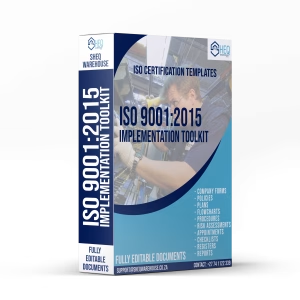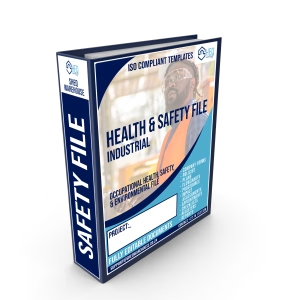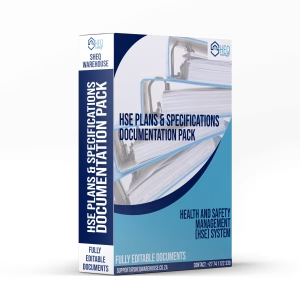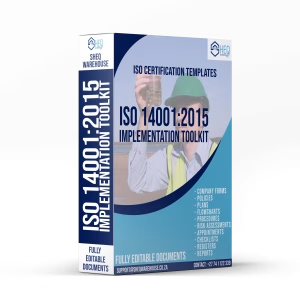Training Material – Mine Safety Regulation
R3650,00
Elevate your mine safety training with our expertly designed training material, crafted specifically for the South African mining industry. This comprehensive package aligns with the Mine Health & Safety Regulation and addresses the 40 critical hazards highlighted in the SA Mining Act and Regulations, ensuring compliance and promoting a culture of safety.
Included in the package:
✔ Mine Health and Safety Regulations – Final.pptx
✔ Mine Health and Safety Regulations – Assessment – Final.docx
✔ Mine Health and Safety Regulations – Facilitators Guide – Final.docx
✔ Mine Health and Safety Regulations – Trainee Workbook – Final.docx
We offer:
✔ Comprehensive, ready-to-use materials to train and empower your or your customers workforce.
✔ Fully compliant with South African mining legislation.
✔ Designed by experts with years of industry experience.
✔ Exceptional value for money.
Transform your operations with this essential training material. Save time, ensure legal compliance, and foster a safer working environment for your team. Perfect for training providers, mining professionals, and safety consultants. This is your ultimate solution for delivering effective and compliant mine safety training.
Description
PRODUCT TABLE OF CONTENT_5
Introduction to SA Mine Safety
Regulation 3.1 – Competent Person Requirements for Electrical Work
Regulation 3.2 – Protection Against Electrical Hazards
Regulation 3.3 – Safety Measures for Electrical Systems
Regulation 3.4 – Requirements for Electrical Installation Areas
Regulation 3.5 – Substation Drawing Requirements
Regulation 3.6 – Substation Safety Signs and Information
Regulation 3.7 – Protection of Suspended Electrical Cables
Regulation 3.8 – Underground Substation Ventilation
Regulation 3.9 – Oil Safety in Electrical Equipment
Regulation 3.10 – Equipment Identification
Regulation 3.11 – Ring Feed and Bus Section Identification
Regulation 3.12 – Voltage Marking
Regulation 3.13 – Working on Live Equipment
Regulation 3.14 – Access Restrictions
Regulation 3.15 – Safety Steps for Working on Isolated Equipment
Regulation 3.16 – Protection of Metal Parts
Regulation 3.17 – Discharging Equipment
Regulation 3.18 – Metal Ladder Ban
Regulation 3.19 – Earthing of Metal Parts
Regulation 3.20 – Earthing Conductor Size
Regulation 3.21 – Procedures for Power Switching
Regulation 3.22 – Protection of Buried Cables
Regulation 3.23 – Rules for Flexible Cables
Regulation 3.24 – Cable Screening Requirements
Regulation 3.25 – Cable Repair Limits
Regulation 3.26 – Cable Reel Safety Devices
Regulation 3.27 – Protection of Cable Trenches
Regulation 3.28 – Overhead Power Line Safety
Regulation 3.29 – Working at Heights Near Electrical Equipment
Regulation 3.30 – Surface Building Wiring Standards
Regulation 3.31 – Overhead Power Line Standards
Regulation 3.32 – Electric Security Fencing
Regulation 3.33 – Underground Helmet Light Rules
Regulation 3.34 – Testing of Helmet Lights
Regulation 3.35 – Portable Lamp Voltage Limit
Regulation 3.36 – General Electrical Equipment Safety
Regulation 3.37 – Explosion Protected Equipment
Regulation 3.38 – Certification Requirements
Regulation 3.39 – Equipment Identification
Regulation 4.1 – Security of Explosives
Regulation 4.2 – Storage and Transport Rules
Regulation 4.3 – Using Explosives
Regulation 4.4 – Who Can Do Blasting
Regulation 4.5 – Testing Equipment
Regulation 4.6 – Safety Checks Before Blasting
Regulation 4.7 – Control of Blast Effects
Regulation 4.8 – No Removing of Stemming
Regulation 4.9 – Waiting Time After Blasting
Regulation 4.10 – Electrical Blasting Safety
Regulation 4.11 – Dealing with Misfires
Regulation 4.12 – Safe Drilling Rules
Regulation 4.13 – Preventing Gas and Dust Explosions
Regulation 4.14 – Proper Hole Filling (Stemming)
Regulation 4.15 – Amount of Explosives
Regulation 4.16 – General Safety Rules
Regulation 4.17 – Special Restrictions
Regulation 4.18 – Gas Exposure Reporting
Regulation 5.1 – Report to Employer
Regulation 6.1 – Time Limits for Safety Discussions
Regulation 6.2 – Rules About Elections
Regulation 6.3 – Setting Up Election Committee
Regulation 6.4 – Election Committee Jobs
Regulation 6.5 – Manager’s Election Duties
Regulation 6.6 – Nominating Safety Representatives
Regulation 6.7 – How to Run Elections
Regulation 6.8 – Full-time Safety Rep Elections
Regulation 6.9 – Appointing Safety Representatives
Regulation 6.10 – Committee Representatives
Regulation 6.11 – How Long Representatives Serve
Regulation 6.12 – Leaving the Position
Regulation 7.1 – Inspector Qualifications
Regulation 7.2 – Inspector Identification
Regulation 8.1 – Air Compressors Simple explanation:
Regulation 8.2 – Underground Railbound Transport
Regulation 8.3 – Train Safety
Regulation 8.4 – Scraper Winch and Mono-Rope Installation
Regulation 8.5 – Lifting Equipment
Regulation 8.6 – Fans
Regulation 8.7 – Refrigeration and Air-Conditioning
Regulation 8.8 – General Machinery Safety
Regulation 8.9 – Conveyor Belts
Regulation 8.10 – Trackless Mobile Machinery (TMM)
Regulation 8.10 – Trackless Mobile Machinery (TMM) (Additional Important Points)
Regulation 8.11 – Lifts
Regulation 9.1 – Environmental Engineering
Regulation 9.2 – Occupational Hygiene
Regulation 10.1 – Hazardous Locations
Regulation 10.2 – Water Storage and Pumping
Regulation 11.1 – Appeals About Medical Fitness
Regulation 11.2 – Annual Medical Reports
Regulation 11.3 – Exit Certificates
Regulation 11.4 – Noise Monitoring
Regulation 11.5 – Asbestos Dust Medical Checks
Regulation 11.6 – Coal Dust Medical Checks
Regulation 11.7 – Crystalline Silica Dust Medical Checks
Regulation 11.8 – Reporting Occupational Diseases
Regulation 11.9 – Record of Hazardous Work
Regulation 12
Regulation 13.1 – Mine Outlets (Exits)
Regulation 14.1 – Entering Working Places
Regulation 14.2 – Restricted Entry
Regulation 14.3 – Old Regulations Cancelled
Regulation 14.4 – Protection Against Water and Fluid Material
Regulation 14.5 – Protection Against Surface Hazards
Regulation 14.6 – Protection of Surface Buildings and Structures
Regulation 14.7 – Cancellation of Old Regulations
Regulation 15.
Regulation 16.1 – Report to Employer Relating to Explosions, Fires and Flooding
Regulation 16.2 – Self-Contained Self-Rescuers
Regulation 16.3 – No Defective Self-Rescuers
Regulation 16.4 – Monitoring Programme for Self-Contained Self-Rescuers
Regulation 16.5 – Emergency Preparedness and Response
Regulation 16.6 – Refuge Bays
Regulation 17.1 – Definitions
Regulation 17.2 – Appointment of Mine Surveyors
Regulation 17.3 – Duties and Responsibilities of Surveyors
Regulation 17.4 – Survey Standards
Regulation 17.5 – Safety Precautions in Surveying
Regulation 17.6 – Advance Warning of Risks
Regulation 17.7 – Mining Near Structures
Regulation 17.8 – Building Near Mine Workings
Regulations 17.9 Submission to Chie Inspector of Mines
Regulations 17.10 – Approval Process
Regulation 17.11 – Boundary Pillars
Regulation 17.12 – Working Through Boundary Pillars
Regulation 17.13 – Check Surveys
Regulation 17.14 – Survey Requirements
Regulation 17.15 – Responsibility for Mine Plans
Regulation 17.16 – Index Key Plan
Regulation 17.17 – Surface Plan
Regulation 17.18 – Surface Contour Plan
Regulation 17.19 – Mine Ventilation and Rescue Plan
Regulation 17.20 – Mine Residue Deposit Plans
Regulation 17.21 – Geological Plan
Regulation 17.22 – Plans of the Workings
Regulation 17.23 – Level Plans
Regulation 17.24 – General Plan for Land Mining
Regulation 17.25 – General Plan for Sea Mining
Regulation 17.26 – Copies for Department
Regulation 17.27 – Unsatisfactory Plans
Regulation 17.28 – Plans Confidential
Regulation 17.29 – Plans Before Mine Closure
Regulation 17.30 – Submitting Final Plans
Regulation 17.31 – Updating After Rehabilitation
Regulation 17.32 – Certificate of Compliance
Regulation 18.1 – Nominations for Representatives
Regulation 18.2 – Appointing Worker Representatives
Regulation 18.3 – Appointing Owner Representatives
Regulation 18.4 – Government Representatives
Regulation 18.5 – Term of Office
Regulation 18.6 – Filling Empty Positions
Regulation 18.7 – Publishing Names




